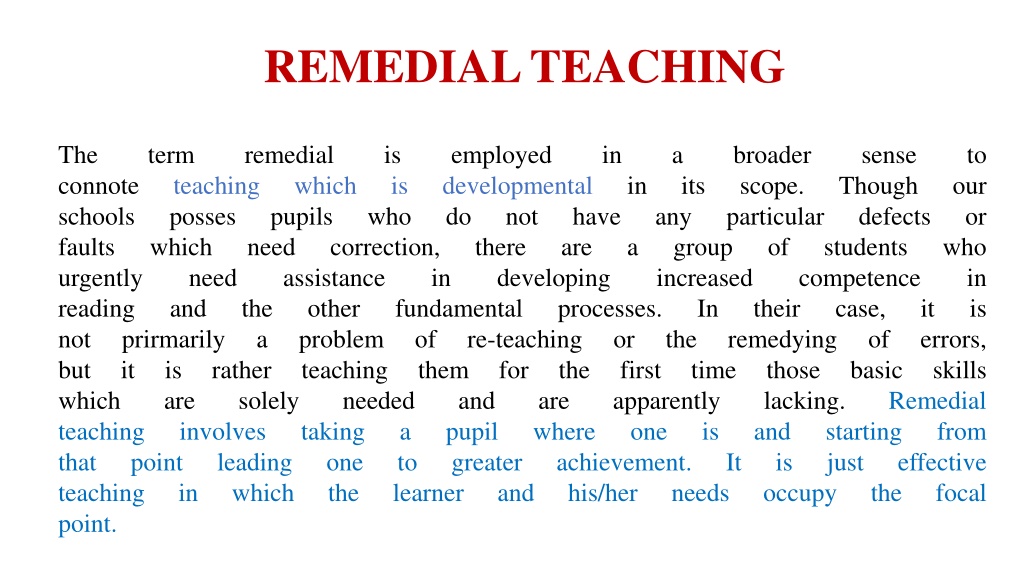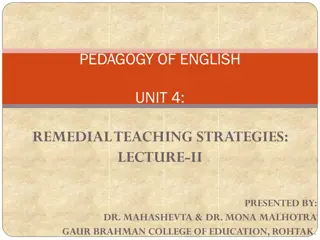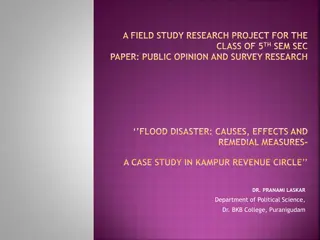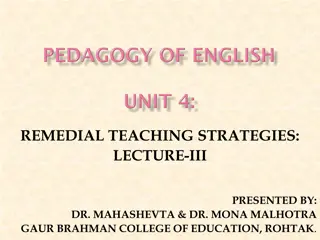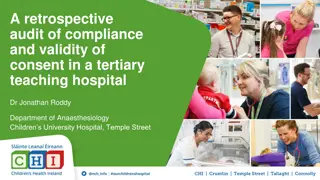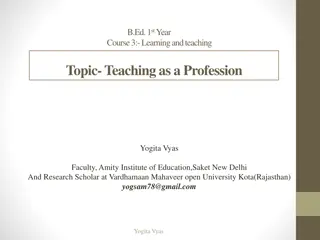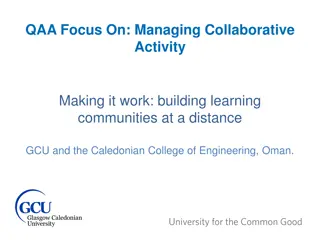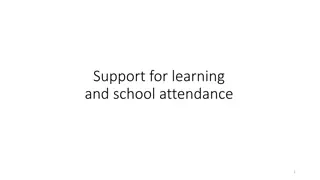Understanding Remedial Teaching for Students' Development
Remedial teaching aims to address students' learning difficulties and help them make up for deficiencies. It involves identifying slow learners through observation of speech, language, behavior, and academic performance. Strategies are then implemented to improve their skills and academic success, focusing on areas such as attention span, comprehension, motivation, and self-confidence.
Uploaded on Oct 02, 2024 | 0 Views
Download Presentation

Please find below an Image/Link to download the presentation.
The content on the website is provided AS IS for your information and personal use only. It may not be sold, licensed, or shared on other websites without obtaining consent from the author. Download presentation by click this link. If you encounter any issues during the download, it is possible that the publisher has removed the file from their server.
E N D
Presentation Transcript
REMEDIAL TEACHING The connote schools faults urgently reading not but which teaching that teaching point. term remedial employed developmental do not there in developing fundamental of re-teaching them for needed and taking a pupil one to greater the learner is is sense Though defects students competence their case, remedying time those apparently lacking. one is and achievement. It his/her needs in a broader scope. particular of to teaching posses which need and prirmarily it is are involves point in which pupils need assistance the other a problem rather solely in its our or who who have are any group increased In the first correction, a in is processes. it errors, skills Remedial from effective the or of teaching the basic are where starting just leading which is and occupy focal
Meaning of Remedial Teaching While diagnosis is the process of investigating the learners difficulties and the reasons for this, its follow up leads to actions that may help children make up their deficiencies. This step is generally termed Remedial Teaching. Definitions According to Billow Remedial teaching is a morale building and an interest building enterprise for the students According to Yoakman and Simpson The purpose of remedial teaching is the development of effective techniques for the correction of errors in all types of learning. As yet, it has been more effectively used in the skill subjects than in the Commerce.
Identification of students for Remedial Teaching Early diagnosis of student is very necessary between the ages of 2 to 6 years. Teachers or parents can identify that the student is a slow learner with a careful observation. They could easily identify some of the signs of a slow learner as follows: 1. Speech defect 2. Language development problem (broken sentences) 3. Assessments the level of vocabulary (vocabulary limited) 4. Verbal abilities 5. Short sentences, grammatically incorrect 6. Student Behaviour 7. Spelling Mistake 8. Interaction with other students 9. Class room Discussion 10. Reading problem 11. Interest 12. Slow response/decision making If it is identified that a student is slow learner , proper evaluation should be done to identify the weakness of the student and relevant strategies must be implemented to overcome it.
Sullivan has summarized the characteristics of slow learners as follows: 1. Short attention and concentration span is less and are easily distracted by other things 2. Slow reaction time. 3. Limited powers of self-direction. 4. Limited ability to work with abstractions and to generalize. 5. Slowness to form association between words and phrases. 6. Failure to recognize familiar elements in new information. 7. Habits of learning very slowly and forgetting very quickly. 8. Very local point of view. 9. Inability to set up and realize standard or workmanship. 10. Lack of originality and creativeness. 11. Inability to analyze, to do problem solving or think critically. 12. Lack of power to use the higher mental processes.
poor memory relatively poor comprehensive power lack of learning motivation lack of self-confidence and relatively low self-expectation fail to grasp information effectively and mix things up easily fail to transfer knowledge to the related learning areas appropriately need more time to complete assignments or tasks
Objectives of Remedial Teaching To timely solve doubts of the students To solve the problems arise during teaching To develop good tendencies among the students To correct the emotional difficulties of students To overcome deficiencies in work, study and skills
Objectives of Remedial Teaching The objectives of remedial teaching is to give additional helps to the pupil who for one reason or another, have fallen behind the rest of the class in the subjects of study like English and Maths etc. Children with learning difficulties have the same psychological needs and characteristics as other children. Some of them however may be less able to organize their preparation or to comprehend abstract ideas and concepts. Some may have poor memory poor motivation, short span of attention in work situation or associated behavioral problems. It must be also be noted that most of the learning difficulties pupils in remedial classes encounter may not be within the child, but are relative to the content where the learning is taking place such as the family background of the child, the physical learning environment of the school etc. Once we understood this, we will begin to view our pupils. From a different perceptive and try to accept their learning difficulties as soluble problem. The ultimate aim of remedial teaching is to helps pupils who have fallen behind to learn to the best of their ability and to bring them back in to the main stream classes as far as possible
Principles of Remedial Teaching Teaching preparation Before preparing for their lessons, remedial teachers should identify pupils' diverse learning needs as soon as possible so that they may design appropriate teaching plans to facilitate pupils' effective learning. Devise various learning activities Since pupils have different characteristics in learning, teachers must devise different learning activities with the same teaching objective to develop pupils' varied abilities and skills in problem solving. It is more effective for teachers to adopt a series of relevant and simple teaching activities than assigning one long teaching activity since pupils may acquire the required knowledge and skills through diversified activities.
Design meaningful learning situations Remedial teachers should specifically design meaningful learning situations, language environments(especially for English subject), games or activities so as to provide personal learning experiences for pupils and stimulate their interest and initiative in learning. Teaching approaches Teachers should give concrete examples before proceeding to abstract concepts by way of simple and easy steps at a pace in line with the learning abilities of students. Teachers may teach new concepts from different perspectives by various approaches so that pupils can grasp the ideas through meaningful and repeated illustrations. Teachers should encourage pupils' active participation by more frequent use of teaching aids, games and activities. They can also make use of information technology and all the teaching resources available to help pupils understand the main points. Provide clear instructions Remedial teachers should give pupils short and clear instructions to avoid confusion. They must explain clearly the arrangement of each learning activity. If necessary, they may ask pupils to repeat the steps of activities so that every pupil may understand the instructions.
Summarize the main points At the course of teaching, teachers should always sum up the main points in teaching and write the key phrases on the board to enhance pupils' audio and visual memories. Teachers can guide their pupils to link up the knowledge they learn from class with their life experiences so as to enhance the effectiveness of learning. Besides, guiding pupils to repeat the main points in verbal or written form is also an effective way of learning. Enhance learning interest and motivation Suffering from frequent frustrations in their work, pupils with learning difficulties may gradually lose their interest in learning. Therefore, teachers should adapt the curriculum to meet the needs of pupils.
Encourage pupils' active participation in class activities Remedial teachers should patiently encourage active participation in class. Pleasurable learning experiences may help enhance pupils' interest in learning. Focus on the learning process Teaching should not only focus on the transmission of knowledge. It is also important to see that pupils are benefited from the entire learning process. Teachers should provide ample opportunities in class for pupils to practice and think what they have learnt, and allow them to solve problems by different means. Teachers should also carefully observe the performances of pupils and give them appropriate assistance, feedback and encouragement so as to help them acquire the learning skills, solve their problems and understand their own capability, thus enhancing self-confidence and improving their learning skills.
Show concern for the performances of individual pupils Pupils may encounter different problems in their studies, therefore, teachers should carefully observe the learning process of individual pupils in class. Whenever necessary, they should provide individualized remedial teaching before and after class, during recess or lunchtime, so that they can remove their learning obstacles as soon as possible. When marking assignments, teachers should take note of the common errors of pupils and deliver the correct concepts and knowledge to them promptly
DEVELOPMENT OF REMEDIAL TEACHING PROGRAMME Remedial teaching is a continuous process involving testing, teaching, testing and re-teaching. In the words of Billows, It is a moral building and an interest building enterprise for the pupils. In the first stage, it requires the selection of backward pupils. This can be done by conducting a pre-test. Once the backward pupils have been identified, the causes of their backwardness can be diagnosed. It is in the third stage that remedial programmes are to be used. Effective follow up is absolutely necessary and the pupils' progress has to be evaluated and in areas where weakness still lingers, remedial work has again to be done, with necessary modifications and adaptations in the light of the experience so gained.
Steps in remediation The program that coincides most closely with the experience of successful teachers and with a sound psychology of learning calls for the following steps in the order indicated (1) teach, (2) review, (3) test for weaknesses wherever they appear, (4) follow with remedial drill units on the specific weaknesses revealed by the tests.
Selection of Materials : The following points should be kept in mind while selecting appropriate instructional material 1) The corrective material should be designed to correct the students individual difficulties. ii) You have to analyze the work of slow learners by means of observation, interview and Diagnostic Testing. A careful consideration of the three may help decide what kind of corrective material is to be designed and whether material will be adequate to correct the specific difficulties of learners. iii) The corrective material should be graded, self-directive and should permit students to work independently. Written directions, which accompany the material, should be easily readable and comprehensible by the students. iv) The corrective material must permit individuals to progress according to their pace. v) The material should encourage systematic recording of evidence of pupils progress
Preparation of remedial materials Preparation of remedial materials for a child is a crucial aspect of corrective instruction. Remedial materials prepared should meet the following criteria: (i) The difficulty of the remedial material should be geared to the child's readiness and maturity in the subject or skill to be improved. A set of remedial materials should provide a wide range of difficulty, covering several grades (il) The remedial measures should be designed to correct the pupils' individual difficulties. Through the use of observation, interview and diagnostic testing materials, the teacher would have analysed the work of the backward children in order to locate the specific retaining needs. An adequate amount of remedial materials must be provided which is designed to correct the specific difficulties identified (iiI) The remedial materials should be self-directive. Children may differ widely as to the instructional materials needed to correct their difficulties (iv) The remedial measures must permit individual rates of progress (v) A method should be provided for recording individual progress. When the child has an opportunity to record his/her successes on a progress record, he/she is given an additional incentive to achieve.
Curriculum Adaptation Remedial teachers should adapt the curriculum to accommodate the learning characteristics and abilities of pupils. They should set some teaching objectives which are easy to achieve to ensure that pupils may acquire the knowledge as desired after the completion of each module. Teaching should not be directed by textbooks which should not be taken as the school curriculum. There is no need to cover all the contents in the textbooks as well. Schools can classify the teaching content into core and non-core learning aspects according to the teaching objectives and pupils abilities. Core learning aspects require in-depth studies and application whereas materials in the non-core or advanced learning aspects may be streamlined or appropriately selected for teaching.
Teachers are encouraged to adopt recommendations on cross- curricular teaching by linking up related teaching areas flexibly so that more time can be spared for effective activities and learning. Teachers should make good use of all teaching materials. For example, they may select and use the materials in textbooks to meet the teaching objectives, or compile their own supplementary teaching materials. They may also design materials of different standards. Materials from the internet, newspapers, magazines and references provided by the Education Department may help teachers design interesting and enjoyable activities to enhance pupils effectiveness of learning.
Homework Policies Schools should formulate clear policies on homework which should be reviewed regularly. The assignments should be targeted at the teaching objectives and serve the purposes of learning. Exercise books available in the market should only serve as a reference. Schools should choose these exercise books carefully and make appropriate adjustments to the category, quantity and quality of homework. Teachers should take note of the following points when designing homework for pupils: the homework should have clear objectives and can accommodate the level and needs of pupils; the form and contents of homework should be of a great variety so as to develop pupils creativity, self-learning and collaborative skills;
the homework should match the content taught in class; teachers should give simple and clear instruction; assign appropriate amount of homework each day; ineffective and mechanical drills should be avoided; and teachers should make good use of the homework as a tool for evaluation and feedback to enhance the motivation and effectiveness of learning
The Setting of Learning Environment Well-designed learning environment helps to maintain pupils attention and interest in learning and facilitates the achievement of teaching aims. In this way, it is more easy to achieve the aim of teaching. The teaching environment should be designed to support remedial teaching and group activities. Seat arrangements of pupils should be flexible to meet the specific teaching purposes of each learning activity. For example, teachers and pupils may form of circle when holding discussions; and the two pupils or group members involved may sit together during peer group or small group learning. Teachers should prepare a rich, pleasant and comfortable learning environment for pupils. For example, they may set up a self-learning corner, book corner, toy corner, science corner, prize corner or stationery/learning resources corner, etc. to enkindle pupils interest in learning. Teachers may display the teaching materials of the week or the learning outcomes or products of pupils at prominent places to stimulate their motivation in learning.
Handling pupils behaviour problems Remedial teachers should observe the following when dealing with the behaviour problems of pupils: always observe the performance of pupils in class and their behaviour in groups; establish close relationship with pupils, develop mutual trust and listen carefully to what they say; help pupils understand the effect of their behaviour on the other as well as their own selves; keep in close contact with parents to find out the cause of pupils behaviour problems; help pupils build up self-confidence and a healthy self-image; give positive reinforcement to pupils good behaviour, and do not pay undue attention to their misbehaviour; do not try to change all the deviant behaviour of pupils at once. Teachers should list out the problems and set the priorities with an aim to improve one or two of them at a time; refer the cases to Student Guidance Officers/Teachers for follow-up action if the behaviour problems of pupils continue or become serious. If necessary, student guidance officers/teachers may refer the case to the Psychological Services Section of the Education Department for individual assessment and remedial services.
Liaison with Parents In order to help pupils with learning difficulties, schools must liaise closely with parents. Apart from providing guidance on homework to their children, parents also handle pupils problems either by the same way or similar ways in line with the requirements of the school and their schoolwork. Some parents may have unrealistic expectation of their children s performance. In such cases, remedial teachers have to explain to the parents about the characteristics and abilities of pupils so that they may help their children to learn in a pleasurable manner. On the contrary, some parents expectation may be too low. Teachers must then keep in contact with parents to help them understand their children and to provide appropriate guidance to develop the pupils potentials.
Co-ordination with Other Teachers and Professionals Remedial teachers must keep in close contact with other teachers. They are encouraged to discuss or share their experiences with others to find out ways to improve pupils learning and behaviour. For example, they may discuss on the teaching plans, learning progress of pupils, test and examination questions, pupils problem behaviour and partial or total withdrawal of pupils Remedial teachers should also liaise with other related professionals to seek for professional support with a view to helping pupils solve their problems.
Development of Generic Skills Remedial teachers should help pupils develop good learning habits and attitudes, such as complete the assignments tidily, keep their promise and be responsible and disciplined. A constructive attitude is the foundation for life-long self-learning and it helps enhance pupils learning effectiveness. Pupils should be helped to master basic self-learning skills and abilities. For example, teachers may teach them how to set appropriate learning objectives and priorities, time management, note-taking, reading skills and examination taking skills, etc.
Remedial teachers can also make use of information technology to motivate and teach pupils to learn according to their own pace, help them cultivate the habit of self-learning, so that they will benefit from such training for their whole life. Pupils can be taught to solve problems by different methods, tools or by drawing insight from their past experiences. For example, teachers can teach them the use of dictionaries, as well as the skills of seeking and handling information obtained from the school and public libraries. These are ways to develop students flexibility, creativity and independent thinking. Teachers should train pupils to establish good interpersonal relationship so as to facilitate effective communication and collaboration as well as to enhance the team spirit of students.
IMPLEMENTATAION OF THE REMEDIAL INSTRUC'TIONAL PROGRAMME Although the selection of the remedial material is highly important, it is only one aspect of the teacher's approach upon learning difficulties and underlying causative factors. The following principles should guide the teacher in planning and carrying out the programme (i) One of the first steps should be the correction of any physical factors, which affect learning (it) The co-operation of the parents should be obtained in correcting such physical factors, alleviating emotional tensions, and providing better study conditions and the like (iii) If the child has little desire to learn, immediate steps should be taken to try to improve his /her attitude through activities which makes the child enjoy learning (iv) Corrective instruction should begin by analyzing with the child the specific strengths and needs, and showing how the instructional materials are designed to correct his / her deficiencies. Making the child aware of his/her problem and providing a method of solving them, based on individual effort, helps to establish a powerful motivating force (v) Instruction should begin at or slightly the learner's present level of achievement. Short term goals should be established which the learner considers reasonable and possible to attain. By means of progress charts, praise and social recognition the child's feeling of successful accomplishment should be reinforced
(vi) Since corrective instruction must usually proceed on the basis of a tentative diagnosis, the teacher must be ready to modify the remedial programme if the approach and materials selected seem to be ineffective (vii) Corrective procedures must be modified for children of relatively inferior or superior mental ability (viii) The results of corrective instruction should be evaluated. Comparable forms of a standardized test should be administered before and after a period of concentrated instruction. The effectiveness of the programme must be evaluated for each child than in terms of class averages (ix) A cumulative record should be made of the results of diagnosis, of methods and materials used, and of the results of corrective instruction. Such a record is helpful in the determination of next steps, and of invaluable help to the next teacher when the child is promoted If the children are assigned to a remedial group taught by a special teacher, great care should be taken to integrate the special corrective programme with the developmental teaching in the regular classroom.
Remedial Teaching Strategies Individualized Educational Programme (IEP) Geared to the learning needs of individual pupils, the Individualized Educational Programme aims to reinforce the foundation of learning, help pupils overcome their learning difficulties and develop their potentials. Individualized Educational Programme should include short-term and long- term teaching objectives, learning steps, activities and reviews to ensure that the programme is implemented effectively. Teaching can be done in small groups or for individual. If necessary, remedial teachers, other teachers, student guidance officers/teachers, parents and pupils alike are to participate in designing the programme. Remedial teachers hold meetings regularly to evaluate the effectiveness of work and gather opinions for refinement.
Peer Support Programme Remedial teachers may train up pupils who perform better in a certain subject to become little teachers and who will be responsible for helping schoolmates with learning difficulties in group teaching and self-study sessions as well as outside class. Peer support programme helps pupils reinforce their knowledge, and develop their communication and cooperation skills as well as good interpersonal relationship. To enhance the effectiveness of the programme, remedial teachers must provide training to the pupils concerned beforehand and make regular reviews on its effectiveness. Generally speaking, this programme is more suitable for pupils of higher grades. Reward Scheme The reward scheme has positive effect in enhancing pupils motivation. It aims at guiding pupils to set their own objectives and plans, and positively reinforcing their good performance. No matter what reward is provided, the most important thing is to help pupils cultivate an interest in learning and gain a sense of satisfaction and achievement during the learning process. give diversified rewards (including verbal commendation) or prizes to accommodate pupils interest; give rewards instantly and review and revise the reward scheme regularly.
Advantages of Remedial Activities in the Classroom A remedial activity is one that is meant to improve a learning skill or rectify a problem area. Remedial instruction involves using individualized teaching of students who are experiencing difficulties in specific subject areas. Remedial instruction might be taught individually or in groups and targets academic weaknesses that may hinder learning. Remedial activities teach basic skills that are the foundation for learning a subject in greater detail, and such skills must be learned before students can develop a detailed understanding- of the topic of study. Learning Basic Skills Students who do not have basic math and reading skills will benefit from attention to remedial activities in the classroom. Using phonics, Dolch words or basic multiplication tables as teaching tools will give students the basic skills they need to advance to a higher academic Reinforcement Students who have been out of school over summer, winter or spring breaks may benefit from remedial teaching over a week or more to reinforce skills they lost due to extended time away from school. Teachers might use flashcards, games or fun activities involving phonics and basic math to help students get back on the learning path. level.
Help for Dyslexia According to research from Carnegie Mellon University, remedial reading instruction can help students with dyslexia overcome their reading difficulties by helping to rewire brain connections. The study, published in the August 2008 issue of the journal "Neuropsychologia," showed that 100 hours of remedial instruction is enough to help students with reading deficits related to dyslexia increase neural connections and increase reading proficiency over the long term. Communication Skills Students who suffer from speech disorders may have trouble with communication in the classroom. Speech disorders are often developmental and may respond to remedial reading instruction. Teaching reading using phonics and sounding-out activities may help students with communication issues from speech-related problems become more academically proficient.
Behaviour and motivation The last but essential advantage is the behavior and motivation. Students who fall behind due to the inability to perform even the most basic tasks in the classroom may develop behavior problems because of their frustration levels. This can also lead to a lack of motivation and the desire to give up altogether. Teaching remedial activities will help students gain general knowledge that can be applied to all subject areas and help reduce feelings of inadequacy that lead to behavior or motivation issues. Generally, teachers provide remedial support for students with learning difficulties in one or all of the basic subjects as necessary. Remedial teaching aims at helping pupils to build a good foundation for subject learning and self-learning. It evaluates the performances of pupils and the progress of learning.
LIMITATIONS OF REMEDIAL INSTRUCTION In Remedial instruction, the teacher is constantly reminded of a principle, which is frequently overlooked in other teaching situations. To a remedial teacher, learning rather than teaching is the goal. The growth of each individual rather than the change in group averages is the criterion of success. Hence the teacher needs a rich background in child psychology and educational diagnosis in order to successfully tackle the variety of individual problems which the child presents themselves. A major problem in remedial instruction is the dearth of effective instructional materials. Most of the published materials have been designed for group instruction. Only a small percentage can be adapted for individual instruction. If the material is graded carefully and provided for ample practice on each of the basic steps, the teacher can adapt it for individual use by providing self- directive instructions for pupils. The teacher who understands the objectives to be attained, the analysis of individual difficulties, the types of materials needed, and the techniques essential for correction can adapt some published materials and develop additional supplementary materials which will be appropriate for corrective instruction.
Many teachers who attempt remedial instruction are faced with unusually large classes or with a large percentage of children in the class who are educationally backward. A beginning teacher with a large number of pupils in need of remedial instruction has to limit one's work to three or four pupils whose needs are greatest. As the teacher gains experience in the programme. He/she will be able to extend remedial instruction to all the children who need it. there is the sense of isolation because someone who get remedial is like isolated from other because that person have to study hard to upgrade the score into better one and by giving the examination or test again it becomes tiring for the students.
CONCLUSION Teachers should design appropriate learning activities in line with the focus of teaching. On the basis of low starting point, small steps, diversified activities and instant feedback, teachers should encourage pupils to participate actively during the learning process to help master the skills and methods of collaborative learning. Diversified teaching activities such as situational teaching, competitions, collation of information, discussion, oral reporting, games, topical research, production of graphs/figures/models, role play, recording, visit and experiments may help pupils enhance their interest in learning, stimulate their thinking and reinforce the effectiveness of teaching Teachers should exercise their discretion in the appropriate use of teaching aids. Appropriate teaching aids not only help to enhance pupils interest in learning, but will also consolidate the knowledge they learned, thus achieving the objective of teaching. Common teaching aids are concrete objects, figures, models, word cards, number cards and audio-visual equipments such as tape recorder, headset, wire free induction loop system and multimedia teaching aids, etc. When designing and using teaching aids, teachers should first consider their practical use and assess whether the aim of remedial teaching can be attained.
The design and organization of teaching materials should be pupil- oriented. They should be selected and collated systematically to serve the purpose. Teaching materials provided by the Education Department or other academic institutions may also serve as a reference for teachers. Grand to the learning needs of individualized educational programme aims to reinforce the foundation of learning, help pupils overcome their learning difficulties and develop their potentials. Remedial teaches hold meetings regularly to evaluate the effectiveness of work and gather opinions for refinement. Remedial teaches may train up pupils who perform better in a certain subject.
References Levy M. (1997) CALL: context and conceptualisation, Oxford: Oxford University Press. Schmid Euline Cutrim (2009) Interactive whiteboard technology in the language classroom: exploring new pedagogical opportunities, Saarbr cken, Germany: VDM Verlag Dr. M ller. Lamy M.-N. & Hampel R. (2007) Online communication in language learning and teaching, Houndmills: Palgrave Macmillan. Shield L. & Kukulska-Hulme A. (eds.) (2008) Special edition of ReCALL (20, 3) onMobile Assisted Language Learning. Davies G. & Higgins J. (1982) Computers, language and language learning, London: CILT. Bush M. & Terry R. (1997) (eds.) Technology-enhanced language learning, Lincolnwood, Illinois: National Textbook Company. Pegrum M. (2009) From blogs to bombs: The future of digital technologies in education, Perth: University of Western Australia Press.
